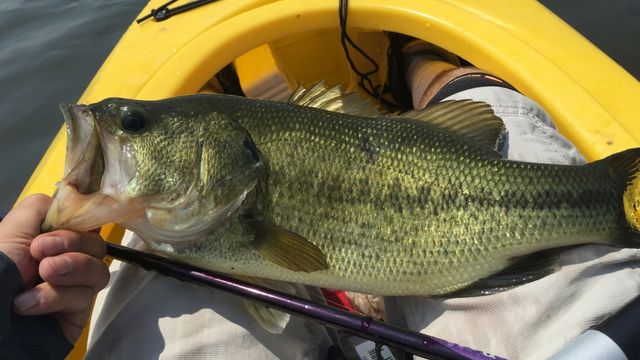
Tips For Catching Post Spawn Bass
Typically when I think of post spawn bass I think of big groups of bass looking for a summer hang out spot. Most bass only spawn for a couple of days before they head on back to the deeper creek channels and main river channels to group up and feed on shad for the summer. I try to target places that are fairly deep water and with a little cover. For deeper lakes I tend to look for longer points that might extend for a couple of hundred feet. Some fish will still be shallow and there are still some big fish left up shallow, but I want to find numbers of fish because they will likely be more active and feeding rather than trying to locate one or two fish up shallow.There are two tactics I really love to do when the post spawn groups appear. There are a variety of different ways to catch these fish from dragging or hopping a jig to swimbaits and spinnerbaits, but this is when I pull out my bigger crankbaits and I will drag a carolina rig. Both require very little skill and are super easy to catch big quality sized fish. Both of these techniques are very versatile and can be used in any water during any conditions.
Post Spawn Tactic 1: Deep Cranking
Deep cranking is a tournament proven way to catch fish. Every pro on the tour will throw a crankbait at some point during the late spring early summer events they fish. Fish are feeding on shad and a crankbait will get a reaction strike every time so fish that are pressured or hugging the bottom will bit a crankbait that come by their face. When cranking a deep plug I first want to identify the water depth and water clarity. I will use Strike King as an example. When I am fishing water the is 10-15 ft I typically look at the 5xd. Then when the fish are really down there in 20 foot plus I will bring out the big guns and throw a 8xd or a 10 xd. The bigger crankbait is perfect in the deeper water column because typically the bigger shad will be swimming deeper so we want to match the size of the shad that the fish are feeding on.Color has two rules that I like to follow. For darker cloud covered days I tend to throw matte or dull colored baits. I want to stay with my more natural colored shad colors and will mix up chartreuse on the bottom or belly of the bait. For clear days where the sun is shining I will go with a color pattern that has a little sparkle in it. I like the lavender shad color or even the citrus shad color works well too. For line, 10 fluorocarbon is the only line I use. The small diameter allows my crankbait to reach that maximum depth and the fluorocarbon is strong enough that breaking off is in the back of my mind. Pair that with a medium-heavy rod with a moderate fast tip with a little backbone, and you have the perfect setup.
Post Spawn Bass Tactic 2: Carolina Rig
Carolina Rigging is a great way to get a bite on a super slow day. I like to think of it as Senko fishing deep water. Most people think that carolina rigging is too slow to fish during a tournament, but that is quite the opposite. When the day hits that lull where fish become less active and the bite has slowed down, the Carolina rig is the perfect way to get a bite. There are two ways I like to fish this setup, and the first way is fishing across a point. I will position myself where I cast across the point I am fishing and drag the bottom all the way back to the boat.The other way I like to fish it is to parallel the channel or structure I am fishing. I will try to keep my bait as close to the fish as possible allowing the slow sinking of the worm or bait to attract the fish off the structure. I have mixed up my worms or soft plastics that I will use and have see the same results with each pair. There are a couple of baits that I never get far away from like a Zoom brush hog and a Zoom ole monster worm. I have also taken it to the extreme and used a 10 inch jelly worm in grape and cherry colors and both have worked really well. The weight varies depending on the bottom, like I use an egg weight for rocky and mud bottom and a bullet weight for grass. I also vary my weight size from a ½ ounce all the way up to a 1 ¼ oz weight. Now the rod and line are the biggest factors in this setup, you need the strong backbone of a heavy rod but the line give you the sensitivity. I usually use 20 lb fluorocarbon line with a 7 foot 3 inch rod. This setup allows for hookups on a long cast.
Updated June 1st, 2017 at 11:50 AM CT
